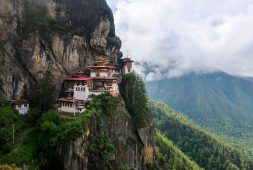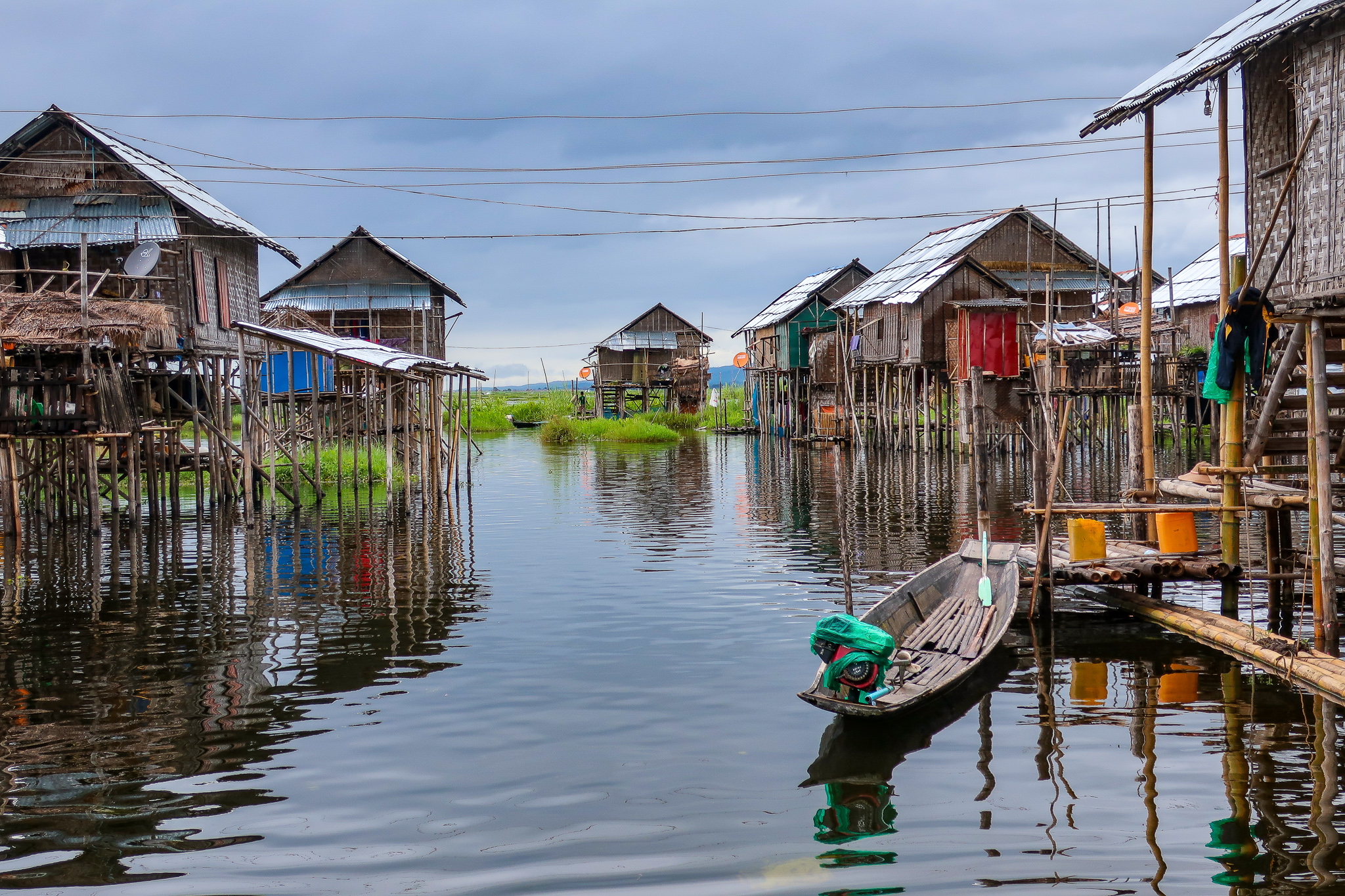
This post is about my adventure at Inle Lake, Myanmar, in June 2018. The post also includes the highlights of Inle Lake as well as tips of how to get to the lake and where to stay.
I had asked the hotel the day before that I would like a boat driver that spoke English in case I had any questions about what I would see throughout the day. Of course the hotel staff didn’t speak the best English, but they assured me the driver spoke English.
It was an early start at 7am. The driver picked me up at the hotel and I asked him how he was doing. He nodded and smiled.
“Do you think the rain will hold off?” I asked. He turned around, nodded and smiled.
“Great” I thought to myself. He didn’t really understand English. As the day went on, it became apparent that my driver did know English, but only the English phrases of where we were going next. I would ask questions about the significance of the sites or what people were doing, and he would just look at me and smile. Cute, but frustrating.
We walked down to the “boat ramp”, which was a muddy section of ground between two buildings leading to the water. I had to climb across several boats to get to the long, narrow boat that would be my ride for the day. A small, metal chair was set up in the middle of the boat with a small cushion for my comfort. It was the only object on the entire deck of the boat. It looked like a throne. After my driver pulled the long cord to start the boat motor, we set out to explore Inle Lake in central Myanmar.
Visiting Myanmar in June is risky since it is the rainy season. As we ventured down the long canal from the main tourist town, Nyaung Shwe, and headed toward the second largest lake in Myanmar, the ominous clouds hovered closely over the lake. Even with the low clouds, it was a beautiful site. Mountains bordered the lake on the east and the west side and the lake went on forever it seemed like to the south. I was excited for the day’s adventure around this massive lake.
Once out of the canal, the driver, I still don’t remember his name, revved up the motor to go full throttle in the open water. The fresh air was refreshing as it blew into my face. But just then, small drops of rain began to hit my face. The rain wasn’t too bad so I just toughed it out. Since we were going relatively fast, I crawled up to the front of the boat as it was slightly tilted up into the air and laid down face up against the bow so the wind would carry the rain drops over me and not get me wet. My driver gave me a thumbs up. At least he speaks the universal code of common sense.
I didn’t know what to expect on this 5-6 hour tour of the lake. Yesterday, the front desk supervisor at my hotel drew small dots on a map of the lake and explained to me in broken English all the sights that I would see on the tour. All I remembered was that I paid a little more to go explore the Shwe Indien Pagoda, one of the oldest in the area. So the rest of the stops would be an adventure.
What I forgot to think about was that I was a tourist exploring a major tourist attraction in the low season. I quickly realized this when we made our first stop at a weaving shop. And then I saw the layout of the building that was all on stilts over water. I noticed that my driver would drop me off at one end of the building and then pick me back up on another side that had the shop to buy the items they were making. It was the typical tourist trap of showing you how the locals make their wares and then walking you through the store with hopes that you will buy something.
I had been traveling for six months and knew this drill all too well. In fact, I try to avoid tours like this because I don’t like feeling the pressure at the end to buy their items. Sure, the process is very interesting with understanding the local traditions and how the local people have survived over the years. I love learning new things but I don’t have extra room in my suitcase to buy something at every tour I go on. I guess if this was your one week vacation then this situation would be very interesting to experience and you most likely would purchase something.
But I did find it very interesting that they were making yarn from a lotus plant. That was unique. I watched the woman break off sections of the lotus stalk grown in the water (similar to a lilly pad stem). When she broke away the stalk section by section, the small fibers along the outside of the stalk would be pulled away and then rolled with other lotus fibers to create the yarn. Then they would dry out the yarn and add beeswax to make the yarn stronger. And eventually they would weave the yarn into scarves. (You can see this process in the video I posted below).
Now came the awkward part. The guide walked me through the extensive gift shop and pointed out everything for sale. Since it is the low season, I am the only tourist they have seen all day. Everyone was staring at me. The awkward feeling begins and I try to think of what to say since I have no interest in buying anything. Plus, most of what they were selling was very expensive since it was hand made and the items were made in the middle of nowhere (literally out in the middle of the lake in a building on stilts).
I used my honest answer which was that I have been traveling for a long time and don’t have room to carry the items with me. Of course they are prepared for any response you provide them and she came back to me with “we can ship any where in the world”. So then I just had to say that I am not interested and slowly walked to my boat parked along the “exit” dock outside. All ten of the local shop workers were staring at me as I walked away. I felt so awkward but my interest today is seeing the unique landscapes and features of this beautiful area, such as the villages built out over the water.
I didn’t look back as the boat pulled away in the canal as I knew I probably would get ten looks of sadness darted right at me. The rain began to fall and my driver gave me an umbrella. He said something in broken English which I believe was explaining our next stop and I smiled and nodded.
This time we pulled up to a boat making factory. And it was the same set up: the local shop owner walks you through how they make the local boats out of trees and uses a rubber sealant to make the boat waterproof. After the five minute explanation, the conversation shifted to all the other goods they have carved out of wood with the expectation that I will buy something. Wooden plates and bottle openers and small figurines. The awkward “no thank you” (said with compassion of course) was my response followed by the sad look of the shop owner.
Next to the wood making shop was local women making cigars out of locally grown tobacco. I could see the women were all talking and not making cigars while the wood maker was giving me his speech about the boats. I felt like I was on a Disney amusement park ride where the moveable objects in front of you don’t start moving until you get closer. Once I started walking up to the women, they stopped chatting and starting making cigars again. And after they explained how they made the cigars, the woman brought over a nice box with cigars for me to smell all the different kinds. Then she lit one up and handed the cigar to me to try.
“I’m sorry, I don’t smoke” I told her. Her face immediately went blank as she quickly realized I wouldn’t be buying anything. It was like she immediately just ignored me. She stopped selling anything else to me. I just sat there in silence. Awkward silence. The women all stopped making cigars and began to chat to each other in Burmese with small giggles here and there. It was like they were talking about me. I guess that was my cue to leave. As I awkwardly stood up, I smiled and walked away.
I crawled back into the boat tied up to the dock and my driver wasn’t around. The shop owner had to go get him. My driver was surprised that the entire stop didn’t take that long. Our next stop was at another shop that showcased a woman from the nearby state of Kayah where it is tradition for women to wear gold rings around their necks. The English speaking guide said that the rings are protection against a tiger bite. I wasn’t quite sure how these rings would truly protect against a tiger that was hungry. If it couldn’t bite your neck, I’m sure it would find other unprotected areas. But I just nodded and went with the explanation.
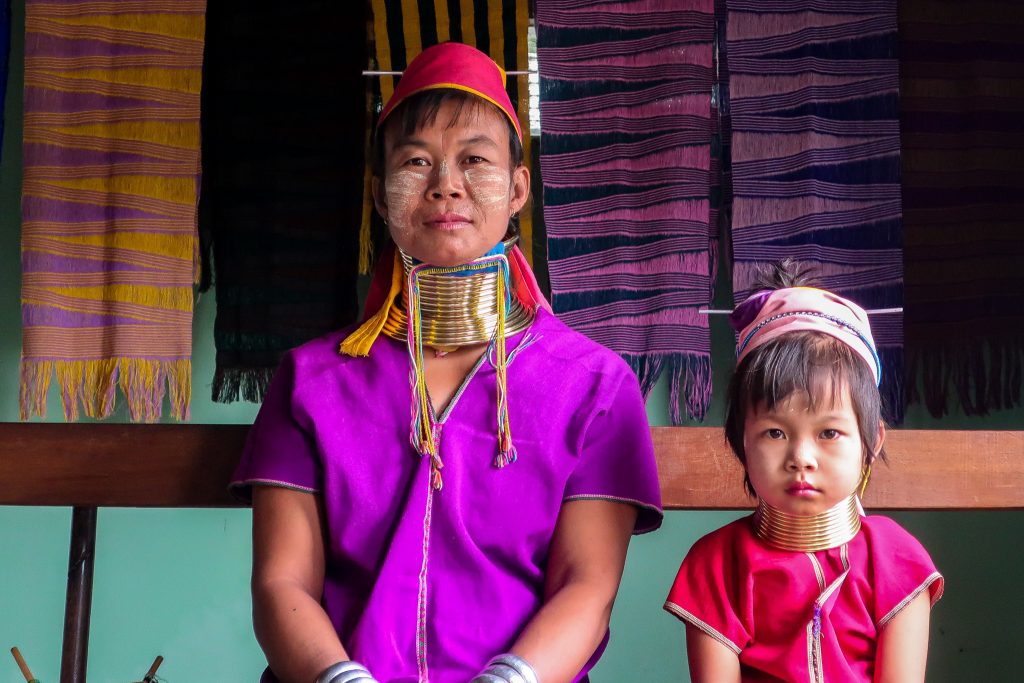
The woman I met began getting the golden rings when she was nine years old and she was in her 40s today. There were probably 18 gold rings around her neck. But the younger generation are given rings that detach so they aren’t permanently on their necks. Since I engaged with the women, I gave them a couple dollars to get photos and a video. After speaking with the woman, another guide walked me into a souvenir shop filled with everything I had already seen in the previous stores.
It is such a dilemma: Do I say “no thank you” before even walking into the shop and be perceived as rude? Or do I go into the shop, entertain their wish of me looking at their items (giving them hope that I will be interested in something), say thank you for showing me around (trying to be nice) and then say I am not interested in buying (potentially wasting their time and be perceived as rude)? It’s like a lose-lose situation.
I chose the latter option. Then came the awkward, “no thank you” moment. As this was occurring and the woman was not taking ‘no’ for an answer, another woman came out and tried to sell me other items. Oh goodness! I felt like I was prey of the predators. I kept saying “no thank you” as I slowly walked toward the boat. It was really awkward. But I got in the boat and the driver was again surprised that my stay wasn’t longer. He should get the hint that I don’t want to see shops or buy anything but I want to see the beautiful natural sites of the lake. I did try to tell him this but here is when an English speaking driver would be very helpful since he only smiled and nodded.
The boat continued on through the village and pulled up to yet another shop. This time it was a silver making shop. You could see the local shop owners come out to the dock as if my driver had called ahead to let them know we were coming. I turned around to my boat driver and motioned to keep going. I don’t want to stop at any more shops! Finally, he got the obvious hint and drove away. I was relieved. That was the last shop we stopped at the rest of the day.
After a couple hours of multiple awkward moments, it was finally time to see the stunning scenery. Check out my day out on the lake in this video.
HIGHLIGHTS OF INLE LAKE
If you find yourself in Myanmar, make sure Inle Lake is on the list of stops. Here are the highlights from my day out on the lake.
Floating garden. Growing tomatoes in a shallow section in the middle of the lake

Floating village. Amazing to see the entire village of over 100 structures up on 2-3 meter stilts in the middle of the lake. I didn’t want to ask where the sewage went since I didn’t see any piping come from the bottom part of the house.
Phaung Daw Oo Pagoda. Myanmar is filled with Buddhist temples and this extensive temple was on an island.
Ride to Shwe Indien Pagoda. The ride through a small river that leads into the lake was worth the trip to Indien since it was an extra fee. The river cascaded down into the lake through manmade bamboo dams that were about 1-2 feet tall across the width of the river. A small opening in the middle of the dam was cut out with water flowing out so these narrow boats could go up (yes, up) the river. The driver would accelerate and the boat would go through the small opening and up the water that was pouring out. We passed through 7-8 of these dams. It was one of my favorite parts of the trip. (The video above shows how it is done)
Shwe Indien Pagoda. Even though I had just come from Bagan and saw hundreds of Buddhist stupas all over (check out my adventure finding hidden temples in Bagan), this temple full of ancient stupas next to each other was still impressive. Most of these temples are in ruins and have been left to the elements of nature. The grass and many trees have grown up through and around the temples giving the area a unique feel. Certainly pay extra to visit this temple. It was the highlight of my tour.
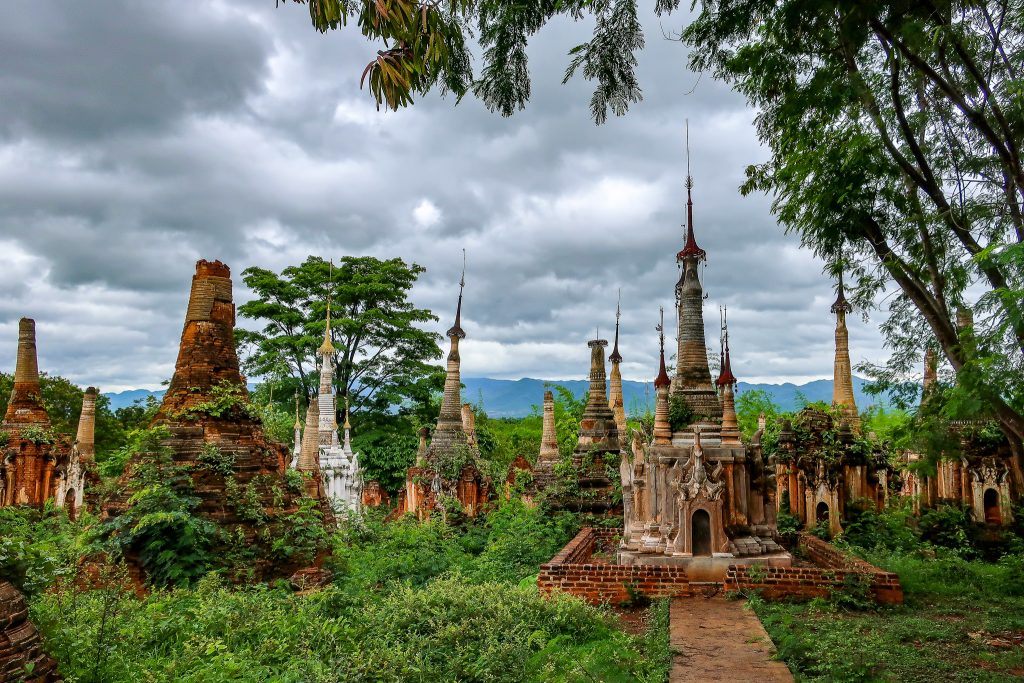
Camera fee. When I entered the long walkway that leads up to the Indien Pagoda, a local woman approached me with a sign that said “500 kyat camera fee”. I was immediately skeptical as my “scam alert” popped into my head (check out my post on how “Getting Ripped Off Erodes Traveler Trust“). There was no official person anywhere collecting a fee nor a sign stating that paying a fee to take photos was an obligation. And then some local Burmese tourists walked by and the woman didn’t say anything to them. After I told her that I wasn’t paying the fee, I continued on up the long walkway, taking as many photos as I wanted and no one said anything. I feel like this is a scam, where the people asking for the “camera fee” look official but they are just local people trying to make extra money. There was also a pay per camera sign at the Phaung Daw Oo Pagoda but locals were inside taking photos and I could see they hadn’t paid a fee (since they weren’t wearing the generic rubber band with a small piece of paper attached that the person gives you when you pay the fee). As I took photos, the guards and pagoda workers all saw me and no one said anything. Just be aware that this could happen. We had to pay a large 13,500 kyat fee to enter the Inle Lake area so my feeling is that any other fees (like a 500 kyat camera fee) should be included in this hefty visitor fee.
Local fisherman. When you buy the Lonely Planet guide to Myanmar, you will see a beautiful photo of a fisherman using one of his legs to row while he stands on the other foot and casts the net with his arms on the front cover of the guide. These fisherman stand so they can see schools of fish in the shallow water from above and cast the net to capture as many fish as possible. It is very unique for this area and there will be many fisherman out on the lake taking this unique form. It is beautiful to watch.
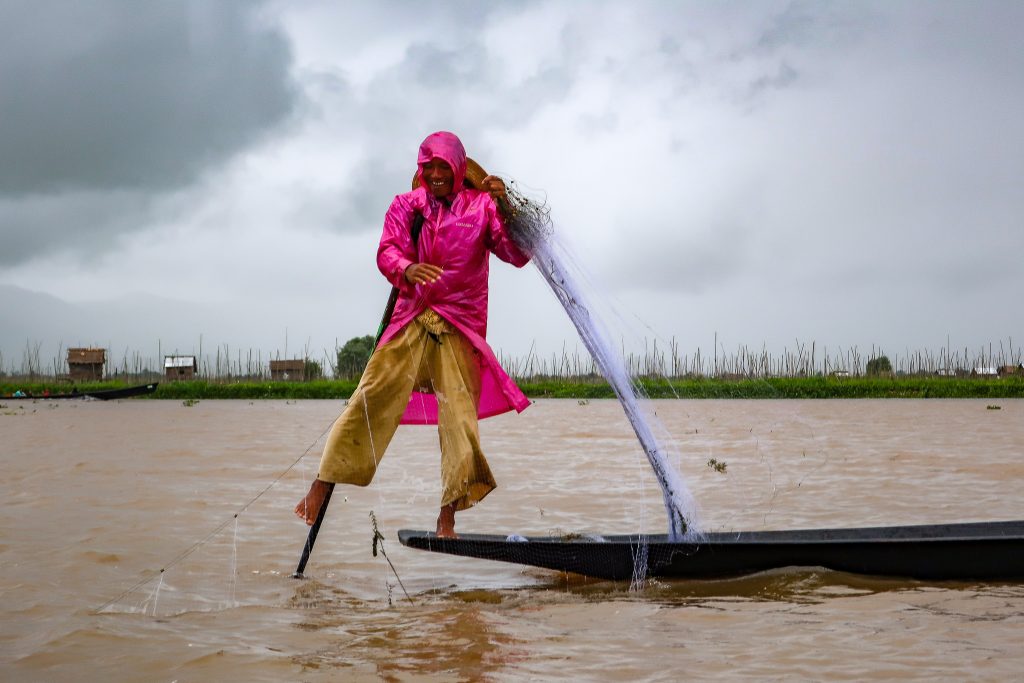
Nga Phe Kyaung Monastery. While it wasn’t my favorite spot on the tour, this monastery is located on an island in the middle of the lake and is certainly unique. It is worth a short visit.
GETTING TO INLE LAKE
By Air. Heho airport is the closest airport to the town of Nyaung Shwe. However it is an hour taxi ride from the airport to the town. Group with other tourists at the aiport to share a ride or arrange with your hotel to have a taxi pick you up.
By bus. Overnight buses arrive from Mandalay, Bagan and Yangon. Just be advised that the only road leading into Nyuang Shwe is over the mountains to get to the lake and is very windy and rough. I took an overnight bus from Inle Lake to Yangon and the first 5 hours were very rough. I suggest taking JJ Express (VIP option) which has been reviewed as the best of the bus options. But I suggest only taking the bus out of Inle Lake and not into Inle Lake due to the mountains at the beginning part of the trip (vs. the end of the trip = early morning).
By train. It is possible to take the train from Yangon to Nyaung Shwe however there is no direct train. You must take the Yangon to Mandalay train and hop off at Thazi (12 hours) and then take a separate train to Nyaung Shwe (10 hours) for a total of 24 hours (two hour wait time at Thazi). But the only reason to take the slow train is to see the unbelievable mountain scenery!
WHERE TO STAY
Most budget-friendly accommodations are in the town of Nyaung Shwe, which is also where most restaurants are located. Also, most boat tours begin along the canal in this town that lead into the lake. I stayed at the Golden Dream Hotel, which had a great location and extremely friendly staff. The hotel’s rooms were large and I felt it was a great overall value, with breakfast included in the rate.
Booking.com
Have you been to Inle Lake? Tell us about your favorite part below!


